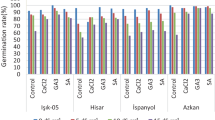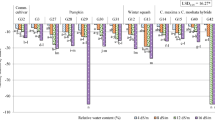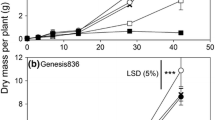Abstract
The salt tolerance of three tolerant accessions of chick pea, CM 663, 10130 and 10572 and three sensitive accessions 10582, 12908 and 12909 selected at the germination and seedling stage was assessed at the adult stage using sand culture salinized with 0, 40 or 80 mol m-3 NaCl. The two tolerant accessions, CM 663 and 10572 and one sensitive, 12908 showed consistent correlation between the degrees of salt tolerance at the early growth stages and adult stage as the former two produced significantly higher seed yield compared with the other accessions and the latter did not survive till seed setting in the salt treatments. By contrast 10130 which was found relatively salt tolerant at the two early growth stages could not survive in 40 mol m-3 NaCl till seed setting. Similarly two sensitive accessions, 10582 and 12909 not only survived at the adult stage but produced some yield as well. On the basis of performance of the six accessions at three different stages, accessions CM 663 and 10572 can be categorised as relatively salt tolerant, 12908 as sensitive and 10130, 10582 and 12909 as moderately tolerant. The tolerant accession CM 663 had high Na+ and Cl- in the leaves but maintained high K:Na ratios and high K+ versus Na+ selectivity. This accession had relatively low leaf osmotic potential which may be due to its high accumulation of Na+ and Cl- in the leaves. By contrast the second tolerant accession 10572 had lowest Na+ and moderate Cl- in the leaves.of all accessions but had highest K+ versus Na+ selectivity, although its leaf K:Na was intermediate. It had also relatively low osmotic potential which cannot be related to different ions determined in this study. The salt sensitive accession 12908 had high leaf Na+ and moderate Cl- but had very low K:Na ratio (less than one) and K+ versus Na+ selectivity. The remaining accessions as a whole did not show any consistent pattern of uptake of different ions. The positive correlation between the degree of salt tolerance at different growth stages do exist in some accessions of chick pea examined in the present study, but for others in which no positive correlation was observed suggests that a combination of certain characters can be used as selection criterion for improving salt tolerance in chick pea.
Similar content being viewed by others
References
Akbar M and Yabuno T 1974 Breeding for saline resistant varieties of rice. I. Comparative performance of some rice varieties to salinity during early development stages. Japan. J. Breed. 24, 176–181.
Ashraf M, McNeilly T and Bradshaw A D 1986 The response to NaCl and ionic content of selected salt tolerant and normal lines of three legume forage species in sand culture. New Phytol. 104, 453–461.
Ashraf M and McNeilly T 1987 Salinity effects of five cultivars/lines of pearl millet (Pennisetum americanum (L.) Leeke). Plant and soil 103, 13–19.
Ashraf M and McNeilly T 1992 The potential for exploiting variation in salt tolerance in pearl millet (Pennisetum americanum (L.) Leeke). Plant Breed. 108, 234–240.
Ashraf M and Waheed A 1992 Screening chick pea (Cicer arietinum L.) for salt tolerance. Der Tropen. S, 45–55.
Ashraf M and Naqvi M I 1991 Responses of three arid zone grass species to varying Na/Ca ratios in saline sand culture. New Phytol. 119, 285–290.
Croughan T P, Stavarek S J and Rains D W 1978 Selection for a NaCl tolerant line of cultured alfalfa cells. Crops Sci. 18, 959–963.
Epstein E 1985 Salt tolerant crops: Origins, development and prospects of concept. Plant and Soil 89, 187–198.
Epstein E and Norlyn J D 1977 Seawater based crop production: a feasibility study. Science. 197, 249–251.
Flowers T J, Troke P E and Yeo A R 1977 The mechanism of salt tolerance in halophytes. Ann. Rev. Plant Physiol. 28, 89–121.
Greenway H and Munns R A 1980 Mechanism of salt tolerance in non-halophytes. Annu. Rev. Plant Physiol. 31, 149–190.
Hewitt E J 1966 Sand and Water Culture Methods Used in the Study of Plant Nutrition. Comm. Agric. Bur. Tech. Commun. No. 22, 2nd edn. CAB Slough, UK. 547 p.
Kingsbury R W and EpsteinE (1984) Selection for salt resistant spring wheat. Crop Sci. 24, 310–315.
Maas E V and Hoffman G J 1977 Crop salt tolerance current assessment. J. Irrig. Drain. Div. Am. Soc. Civ. Engrs. 103, 115–134.
Maas E V and Nieman R H 1978 Physiology of plant tolerance to salinity. In Crop Tolerance to Suboptimal Land Conditions. Eds. ASSA, CSSA. pp 277–299. Madison, WI.
Moftah A E and Michel B E 1987 The effect of NaCl on solute potential and proline accumulation in soybean leaves. Plant Physiol. 83, 238–240.
Muhammad S, Akbar M and Neue U H 1987 Effect of Na/Ca and Na/K ratios in saline culture solution on the growth and mineral nutrition of rice (Oryza sativa L.). Plant and Soil 104, 57–62.
Noble C L, Halloran G M and West D W 1984 Identification and selection for salt tolerance in lucerne (Medicago sativa L.). Aust. J. Agric. Res. 35, 239–252.
Pitman M G 1976 Ion uptake by plant roots. In Transport in Plants. II. Part B, Encyclopaedia of Plant Physiology. Eds. U Luttge and M G Pitman. pp 95–128. Springer-Verlag, Berlin.
Sandhu G R and Malik K A 1975 Plant succession — a key to the utilization of saline soils. The Nucleus 12, 35–38.
Shannon M C 1984 Breeding, selection and the genetics of salt tolerance. In Salinity Tolerance in Plants — Strategies for Crop Improvement. Eds. R C Staples and G H Toenniessen, pp. 231–254. John Wiley and Sons, New York.
Slatyer R O 1961 Effects of several osmotic substrates on water relationships of tomato. Aust. J. Biol. Sci. 4, 519–540.
Winter E and Lauchli A 1982 Salt tolerance of Trifolium alexandrinum L. I. Comparison of the salt response to T. alexandrinum and T. pratense. Aust. J. Plant Physiol. 9, 221–226.
Wyn Jones R G 1981 Salt tolerance. In Physiological Processes Limiting Plant Productivity. Ed. C B Johnson. pp 271–292. Butter Worths, London.
Wyn Jones R G, Brady C J and Speirs J 1979 Ionic and osmotic regulation in plants. In Recent Advances in The Biochemistry of Cereals. Eds. D L Laidman and R G Wyn Jones. pp 63–103. Academic Press, London.
Author information
Authors and Affiliations
Rights and permissions
About this article
Cite this article
Ashraf, M., Waheed, A. Responses of some genetically diverse lines of chick pea (Cicer arietinum L.) to salt. Plant Soil 154, 257–266 (1993). https://doi.org/10.1007/BF00012531
Received:
Accepted:
Issue Date:
DOI: https://doi.org/10.1007/BF00012531




